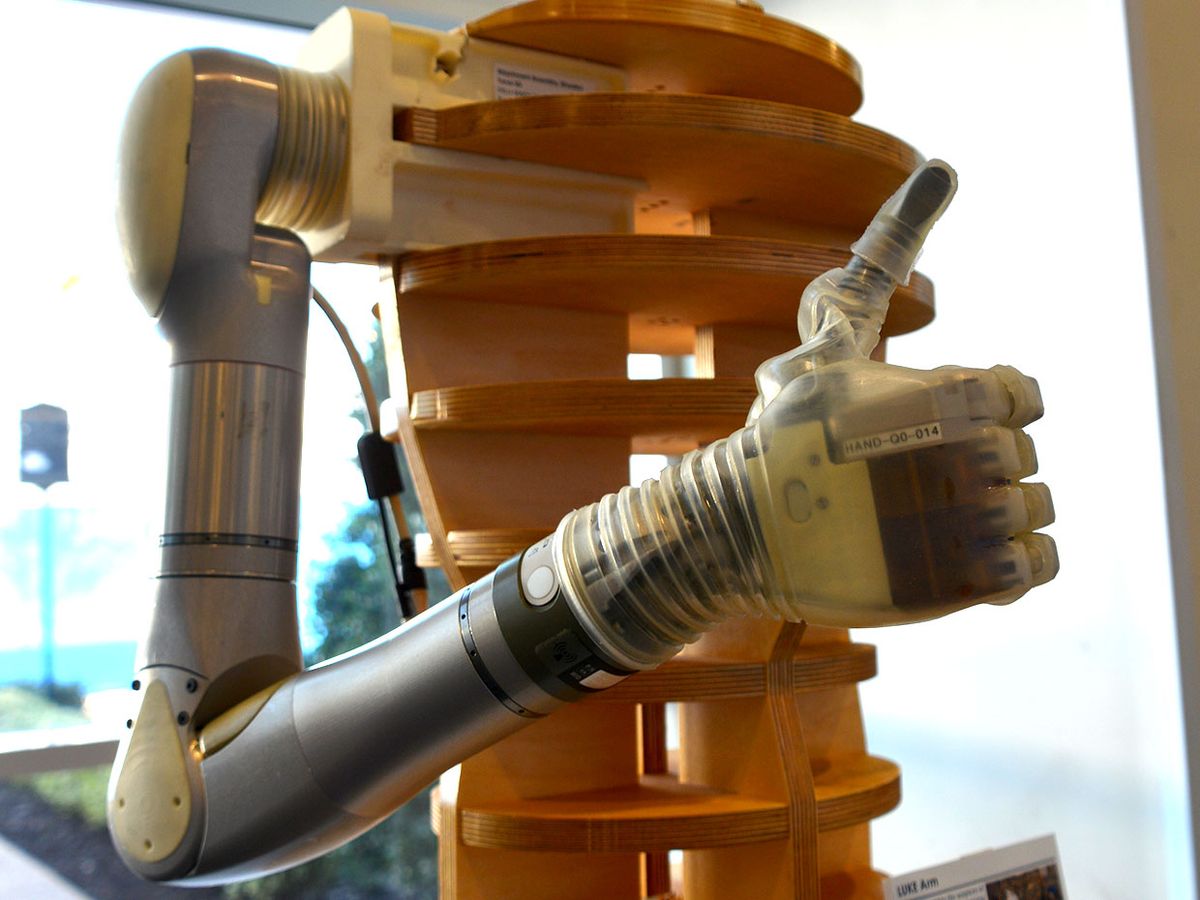This year, the U.S. Defense Advanced Research Projects Agency (DARPA) turned 60. To celebrate, DARPA held a conference in Washington, D.C. One of the highlights was an exhibit hall full of both current DARPA programs as well as unique artifacts from DARPA's history. We've put together a gallery of the most interesting things we saw there. If you'd like to see more, DARPA also published a 140-page retrospective on what they've been up to over the last half century, which you can download here [PDF].
Transit 1

Before there was GPS, there was Transit, a satellite navigation system developed by DARPA and Johns Hopkins University’s Applied Physics Lab for Polaris ballistic missile submarines. Operational from the 1960s through the mid-1990s, ground receivers used the Doppler shift of the satellite's signal to calculate their location within a few tens of meters. Transit was one of the earliest space-related activities that DARPA participated in.

DARPA funded Boston Dynamics to create RHex, a hypermobile robot able to handle all kinds of terrain. It can traverse sand, gravel, mud, and even swim in water, all without any kind of sophisticated sensing or gait planning. RHex is still active in the robotics research community, and its success helped inspire other DARPA robotics programs, as well as many other Boston Dynamics robots.
LUKE Arm

DEKA's LUKE Arm was part of DARPA's Revolutionizing Prosthetics program. It allowed amputees intuitive control over a highly dexterous robotic arm, using accelerators mounted on their shoes. LUKE stands for "Life Under Kinetic Evolution," but it's also a reference to Luke Skywalker from Star Wars, who sports a robotic arm that's only slightly more complex. The LUKE Arm is now commercially available.
Computer Mouse Prototype
The first computer mouse, which was carved out of wood and had one single button, was invented in 1964 by Douglas Engelbart at SRI. Engelbart's funding came from the Information Processing Technology Office at ARPA (the "D" in DARPA was added in 1972), although DARPA was only able to hold onto a replica of the real thing—the plate on the side says "9 of 20."
"Virginia Slims" Miniature GPS Receiver

Between 1988 and 1993, the Department of Defense purchased 1,400 GPS receivers designed to be used by troops. Each one weighed 17 pounds and cost $45,000. DARPA, meanwhile, was working on GPS receivers [PDF] that were intended to be about the size of a pack of cigarettes. The miniaturized unit pictured here was nicknamed "Virginia Slims" due to its size and shape, and Rockwell Collins was ready to produce them by 1991. It was the first GPS receiver that could be plausibly called "handheld."
Micromirror Wafer

Under DARPA's High Definition Systems program, Texas Instruments developed and produced these wafers full of micromirror chips. Each chip contains millions of micromirror elements, which can steer projected light as part of high-definition video displays, like the ones you find in movie theaters. This technology was awarded both an Emmy and an Oscar, but even more important, it made it into IEEE Spectrum's Chip Hall of Fame.
Controlled Biological Flight and Olfaction

Colorado State researchers attached miniaturized neural interfaces to the antennae and flight muscles of moths to figure out how olfaction relates to flight control. I can't find much more info on these bugs, which usually means that they've been militarized, classified, and are probably flying around outside your window. Right. Now.
Hummingbird Nano Air Vehicle

The size and shape of a real hummingbird, this nano air vehicle (developed between 2008 and 2011 by AeroVironment) is fully operational. It can fly in any direction (even backward) at nearly 18 km/h, while carrying a useful surveillance payload for up to 10 minutes. Obviously, the program was a success, leaving us wondering how exactly this technology has progressed over the past eight years. Very secretly, we can only assume.
Printable Solar Cells

This is a functional three-layer solar cell that has been spray-painted onto a rock. It was demonstrated to DARPA in 2003, as part of a "seedling" effort that included contributions from the Naval Research Lab, Geo-Centers Inc. (a military contractor), and the University of Kentucky. The idea was that the military could use solar paint as a power source for covert operations. Since then, other solar paints have been demonstrated a little more publicly.
Ultralight Microlattices

With DARPA funding, Hughes Research Laboratories (HRL) developed a technique for building microlattices out of plastic, metal, or ceramic in less than a minute. These structures are made from hollow tubes, the walls of which are 1,000 times as thin as a human hair, resulting in a material that's 99.9 percent air—one-hundredth as dense as Styrofoam. Microlattices, HRL says, "could be used for battery electrodes, catalyst supports, and acoustic, vibration, or shock energy damping."
Exacto Guided Bullet

It doesn't look like it, but this 0.50 caliber Exacto (EXtreme ACcuracy Tasked Ordnance) bullet is actively guided, meaning that it can change its trajectory in flight to compensate for wind, follow a target, or correct its aim. Without any visible fins or anything like that, the way that the bullet steers is classified. The bullet was successfully test-fired in 2015, and allowed an inexperienced shooter to hit a moving target.
LightningStrike VTOL X-Plane Demonstrator

Aurora Flight Sciences built this 20 percent scale demonstrator X-Plane for DARPA, to test vertical takeoff and landing through distributed electric propulsion. Eighteen electric fans on the main wings plus six on the front canards are powered by a single turboshaft generator, and both the wings and canards can rotate a full 90 degrees. Originally, DARPA had planned to fund a full-scale demonstrator, but they decided that this 20 percent scale version was enough of a proof of concept that the technology is now ready to transition into the commercial sector.
MAD-FIRES Guided Projectile

The Multi-Azimuth Defense Fast Intercept Round Engagement System is DARPA's attempt to combine the accuracy of missiles with the "let's just fire lots of them because they're cheap" of bullets. Medium caliber projectiles that are actively guided and can alter their flight path in real time could track lots of different moving targets while being one-tenth as expensive to fire.
Gremlins Mockup

Gremlins, named after creatures in folklore that cause otherwise unexplainable aircraft malfunctions, seems like a weird choice for the name of a drone program—but these versatile drones are designed to stop functioning after 20 uses or so, bringing their cost way down relative to other drones. They're also designed to be launched and recovered in midair by cargo aircraft, using the system shown here.
Lidar on a Chip

Two years ago, we saw a DARPA and MIT project at the Pentagon Science Fair working toward a single-chip lidar sensor. At D60, the technology has now made it into a functional chip that can be mounted on a drone—the tiny rectangle next to the lens of the GoPro is an operational lidar system, including both the emitter and receiver. Analog Photonics is commercializing this technology, and they've promised us more details soon.
PowerSwim

DARPA is the first to admit that this thing "looks kind of odd," but PowerSwim is able to convert up to 80 percent of underwater motion into forward propulsion, as opposed to just 15 percent for traditional fins. PowerSwim straps to your shins, with one wing by your feet and the other near your waist. As you bend your knees, the wings move up and down, propelling you forward twice as fast with way less effort.
Evan Ackerman is a senior editor at IEEE Spectrum. Since 2007, he has written over 6,000 articles on robotics and technology. He has a degree in Martian geology and is excellent at playing bagpipes.




